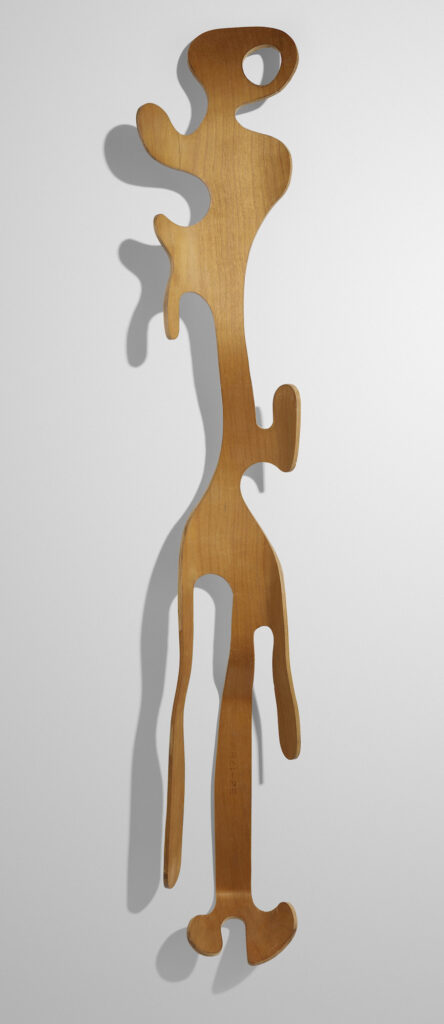
No, there is another. Eleven years ago, I wrote about reconsidering the Eames Studio, and especially Ray Eames, as artists.
Continue reading “Ray Eames Splint Sculpture”the making of, by greg allen

No, there is another. Eleven years ago, I wrote about reconsidering the Eames Studio, and especially Ray Eames, as artists.
Continue reading “Ray Eames Splint Sculpture”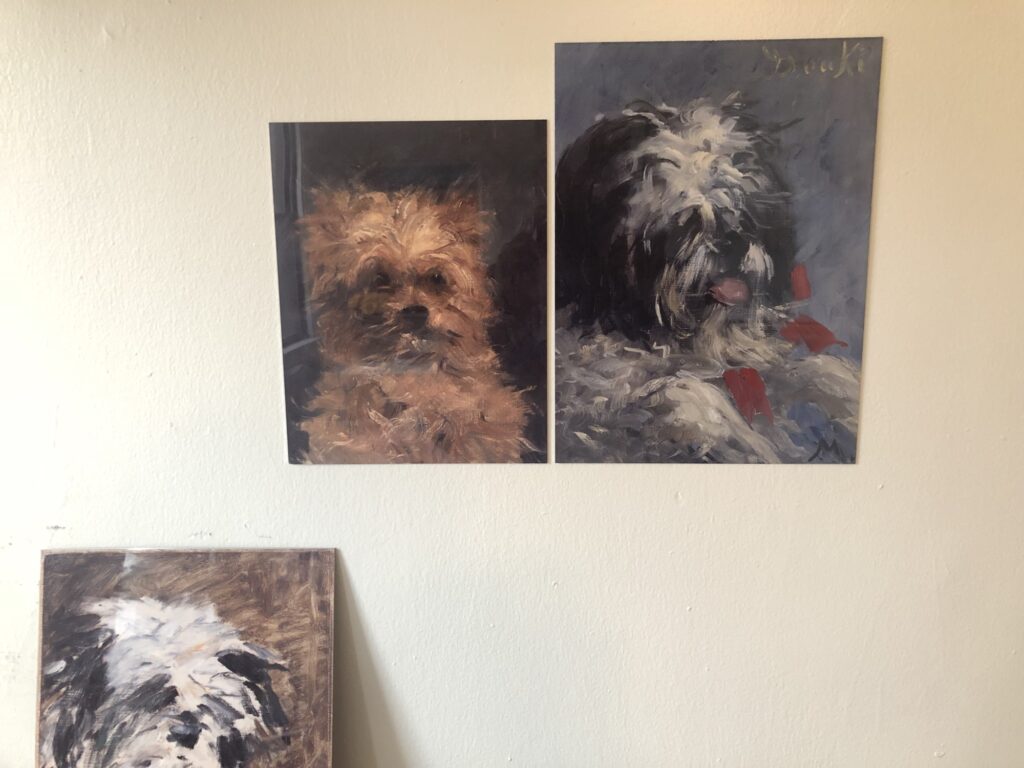
The time-limited edition is now. Wouldn’t it be ironic if you couldn’t see Manet’s “Minnay” in Paris last year because of COVID, and you don’t get to see Manet’s “Bob” and “Donki” (sic) in New York this year because you went straight to London from Paris? Is that how irony works?
Anyway, the Getty Manets go on view at Christie’s this morning. The Getty Manet Facsimile Object Diptych goes on order now. They are priced at 0.1% of the combined estimated reserve price of the Getty’s Manets. After/if “Bob” sells on the 20th, ÉMFO (M3) “Souki” will remain available until “Donki” (sic) sells on the 21st. [If you’re a connoisseurial cabal planning to break up a set from the get-go, I’ll let History judge you, but do let me know, since otherwise, they will come in a custom, diptych portfolio.]
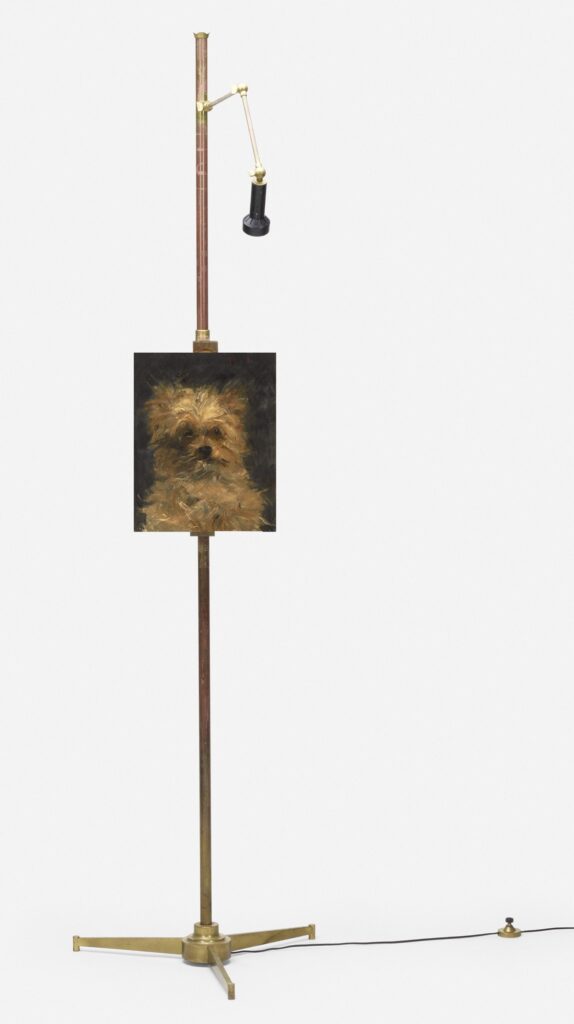
People display their Facsimile Objects in many ways. Some hang them straight on the wall. Some on a little shelf. Or a little easel. Some frame them. An option I’ve never seen but suddenly want is to install them on Angelo Lelii’s elegant bronze Arredoluce easel floor lamps. There’s one (attr.) at Wright20 right now for $5-7,000, with no reserve and a $100 opening bid, which is enticing. Facsimile Object collectors will need to acquire them separately, but if you are the Manet(s) buyer seeking to trade, I will gladly include Italian mid-century bronze easel floor lamps along with your reserved Facsimile Objects. We can make this happen.
[10/20 UPDATE: OK, wow, the Manet painting of Bob the Dog just sold for $1.38 million, more than double the high estimate. If you want to buy the Manet Facsimile Object (M2) “Bob,” by itself or as part of the original diptych, go for it. It’s still 0.1% of the price of the painting. Both Manet Facsimile Objects will remain available, together or separately, until Manet’s “Donki” sells Friday morning. And now le chien “Donki” (sic) has sold for $378,000, almost a million dollars less than “Bob”. What a world. Thanks again to the savvy collectors who are putting their Facsimile Objects to work, and saving 99.9% in the process.]
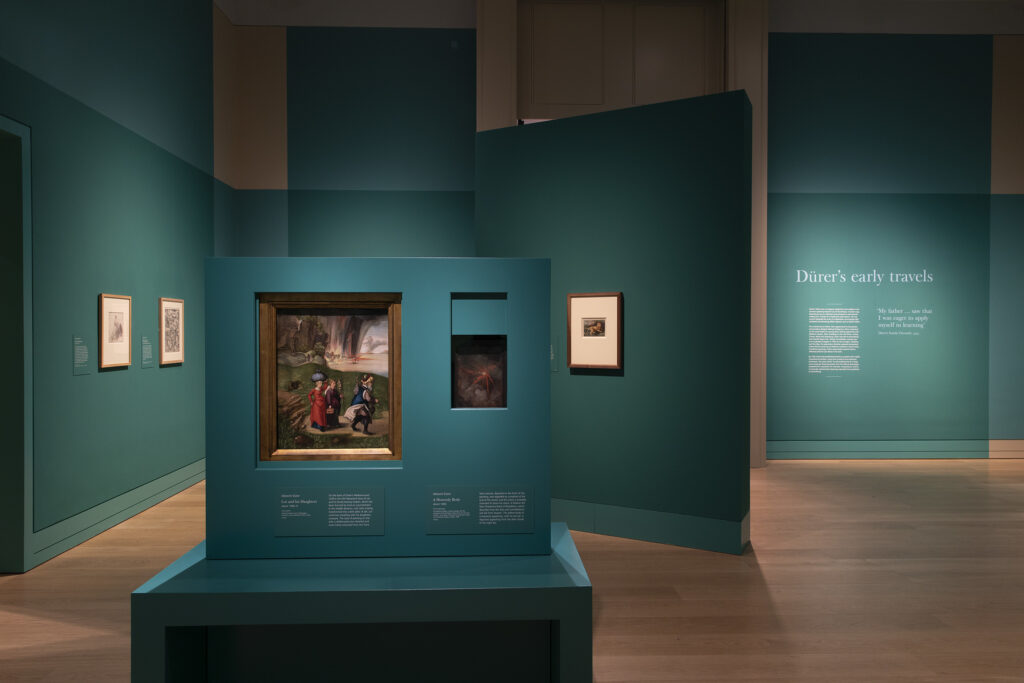
No reason, but I woke up thinking about The Credit Suisse Dürer Diptych, a surprising pairing of two paintings which have ominous visions in the heavens and apocalyptic destruction raining down from the sky, beautifully painted on their reverse sides. Last year, in the midst of the Omicron surge, the National Gallery in London brought these two paintings together for a Dürer show sponsored by Credit Suisse.
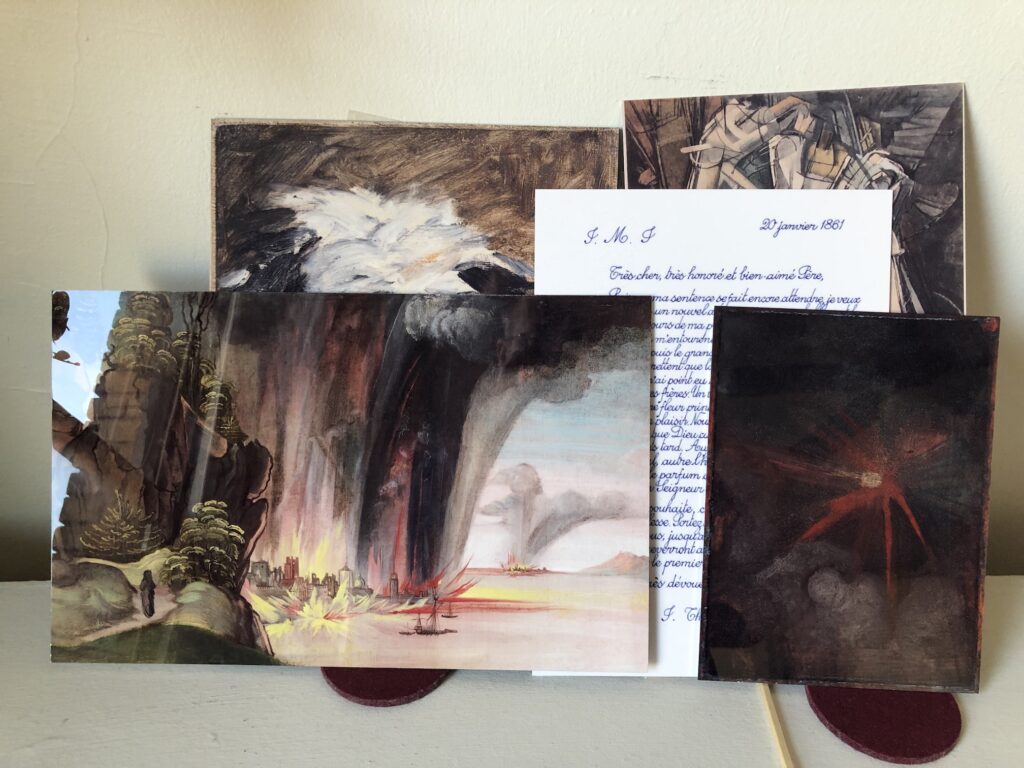
I was reluctant to make Facsimile Objects of these paintings, but felt compelled by the concepts I’d constructed for myself and the project. It wasn’t my fault the world–or at least the museum–didn’t close to limit the spread of the pandemic.
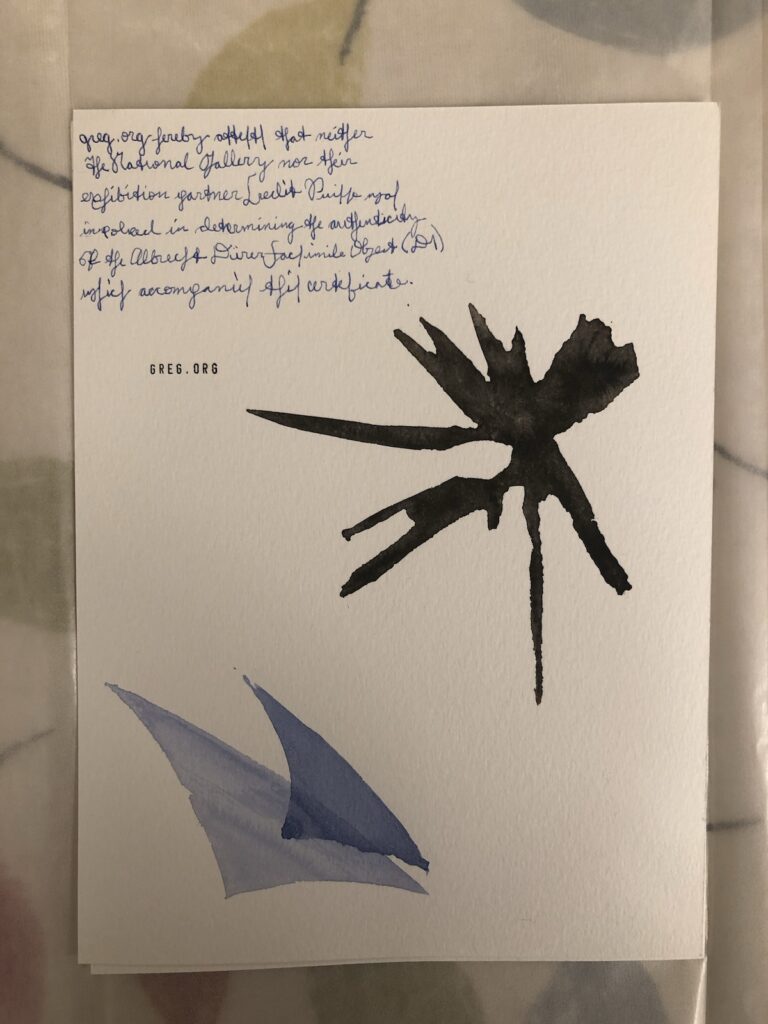
And I don’t know when exactly, but very early on I decided not to show or promote the Certificates of Authenticity I was including. Actually, at first, it was because they didn’t yet exist when I was promoting the first FO, and I did not know how they’d turn out, or even what they’d be. Soon, though, I saw them, not just as part of the concept of a Facsmile Object, but part of the experience of owning it. Not secret, necessarily, but private, individual, and distinct from encountering the project online, where a jpg’s a picture. Some folks have since posted pics of their COAs online, or processed them with their registrars, and that is fantastic, the choice is theirs.
Anyway, for the Credit Suisse iteration, I also wanted to make the Objects distinct from the earlier versions, too. After some exploration and experimentation, I arrived at adding the Credit Suisse logo, a stylized set of sails, to the Certificate.
Looking at my janky rendition of 15th century German calligraphy reminded me that I used to know Richard Jenrette, one of the founders of the investment bank Donaldson, Lufkin, Jenrette. He’d attended the same high school as me in Raleigh, and returned to make a large donation, and I heard he collected houses. I filed that data away and decided to become an investment banker someday, whatever that was. Later on, as I was preparing to go to business school, I was introduced to him at, of all places, Christie’s. We’d cross paths occasionally at galas, art fairs, the Winter Antique Show, etc., and when he gave me a copy of his memoir, I sent him a thank you note. In the last chapter of his book about his amazing career innovating analytical models and methods to the financial industry, he also said he was very into handwriting analysis. I never saw or heard from him again after that, and I sometimes wondered if I’d been blackballed for some psychological flaw revealed in my handwritten note.
Jenrette had already retired, but in 2000 DLJ was acquired and absorbed by Credit Suisse First Boston. The brand lives on in a couple of private equity divisions, but it’s really not the same. Anyway, smooth sailing, Credit Suisse!
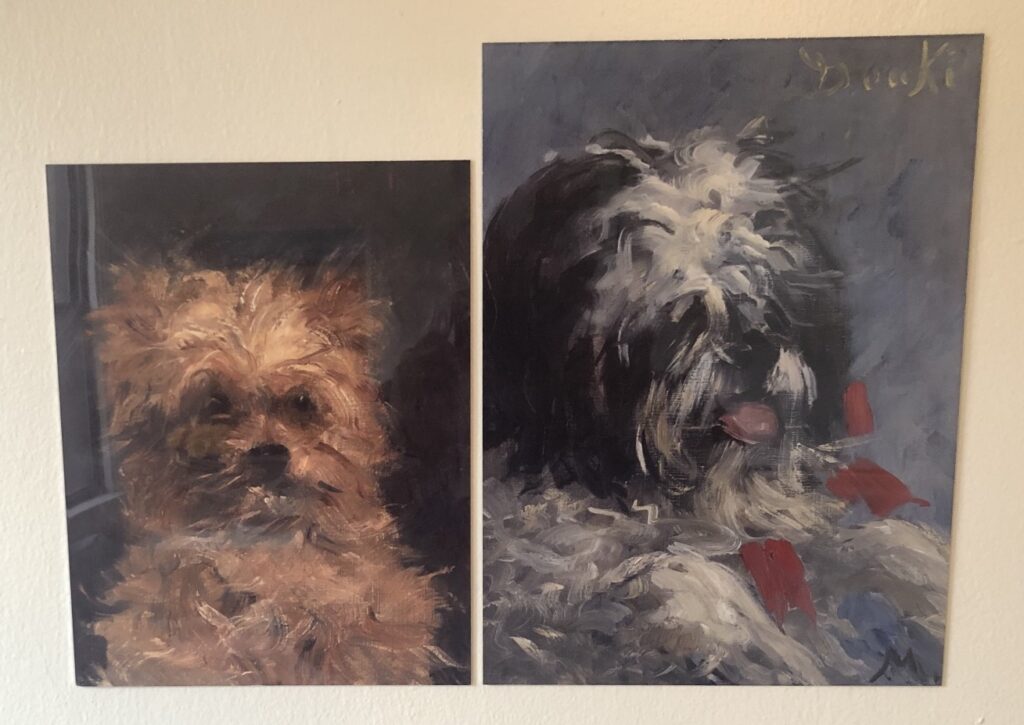
In times like these I turn to mangling words of Samuel Beckett. “Édouard tried. Édouard failed. No Manet. Try again. Fail again. Fail better.”
[10/20 10/21 UPDATE: AND THE TIME TO FAIL AGAIN IS NOW. The link to purchase Manet Facsimile Objects (M2) & (M3) is was below.]
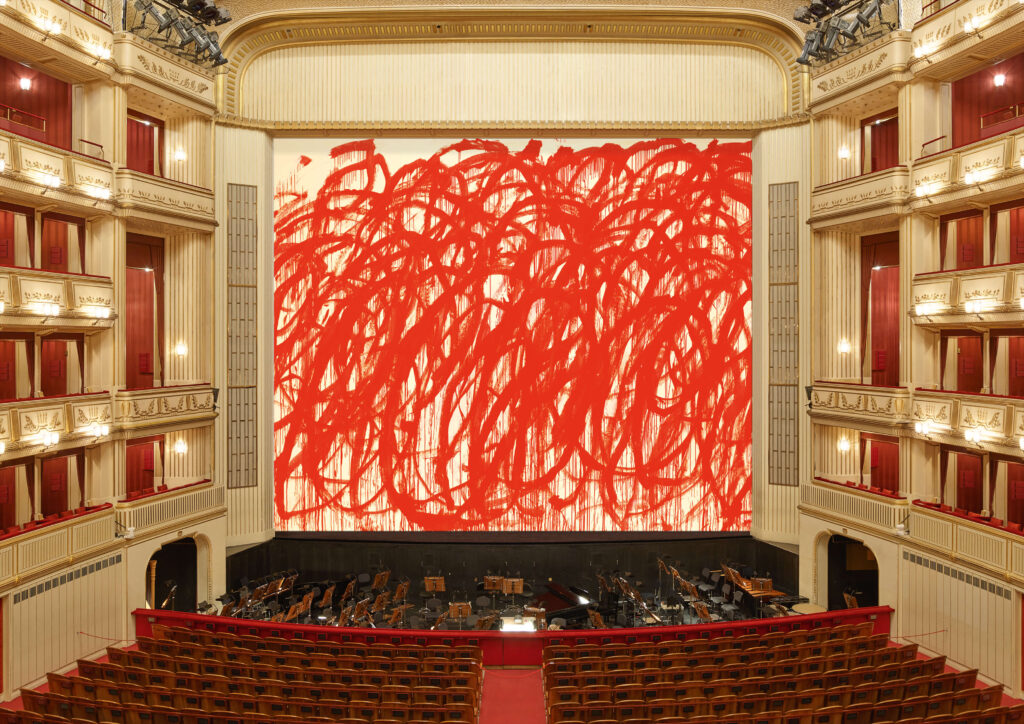
I saw this gigantic Cy Twombly painting on the landmarked firewall of the Vienna State Opera, called the Iron Curtain, and was like, that is totally fake. It is a rendering. And it was.
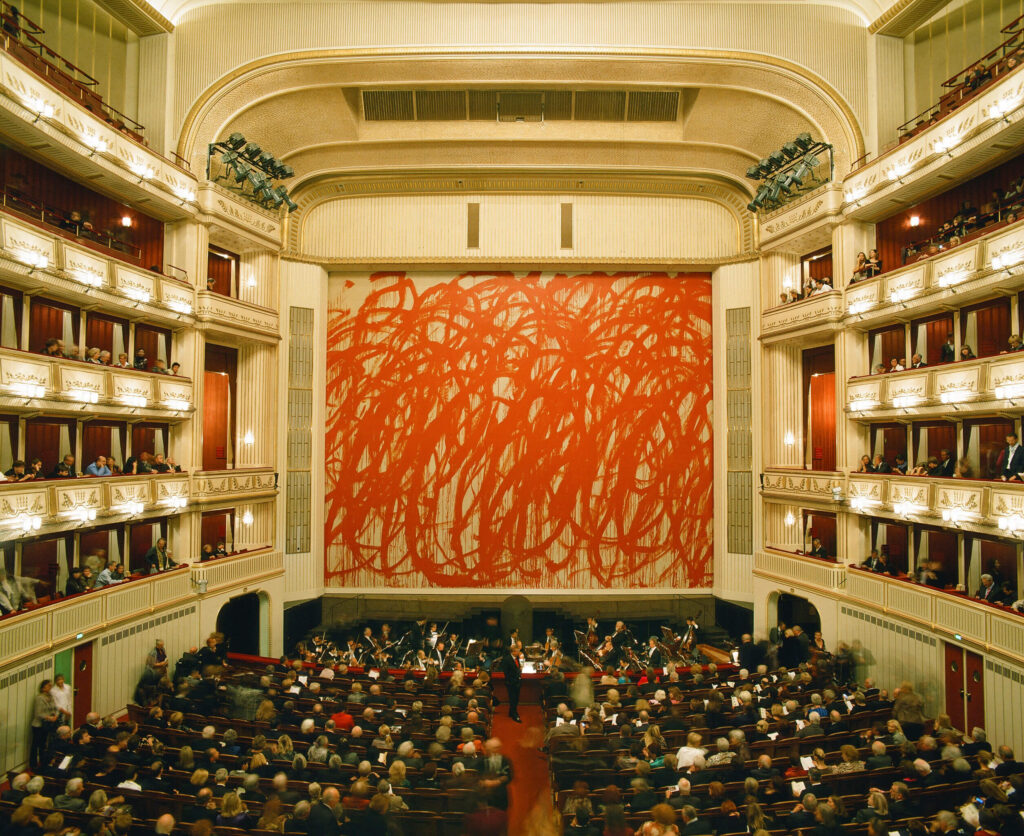
This is what the Twombly fire wall looked like installed in 2010-11. So pretty close, except for the color of the canvas and the paint. Except this 176 square meter image was inkjet printed on PVC mesh, like a billboard. The picture is of an untitled 2005 painting from the Bacchus series. Twombly painted these dripping red loop paintings with giant brushes on sticks, like if Cold Mountain-era Brice Marden just got back from the Iraq War. Everyone wants the Bacchus paintings to be about the Iraq War.
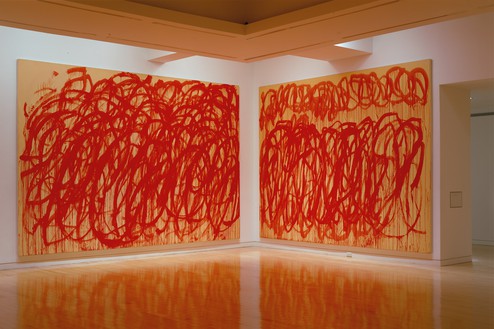
The original is 10×16 feet or so. Here it is installed at Gagosian in 2005. They really cropped that right down. In 2008, between this show and the Vienna State Opera commission, Twombly showed a couple of a third batch of Bacchus paintings at Tate Modern. After his death, the Foundation ended up donating three of them, plus some sculptures, enough to fill a permanent room, which feels astute.
The Safety Curtain Project has been selecting contemporary artists for the Vienna State Opera fire wall since 1998. It is run by Daniel Birnbaum and Hans-Ulrich Obrist, the only two curators in Europe. Oh wait, there’s a third now. Bice Curiger has joined the group chat. I love them all like brothers, sisters, and/or non-binary siblings, but seriously, enough.
Previously, related: Destroyed Cy Twombly Backdrop
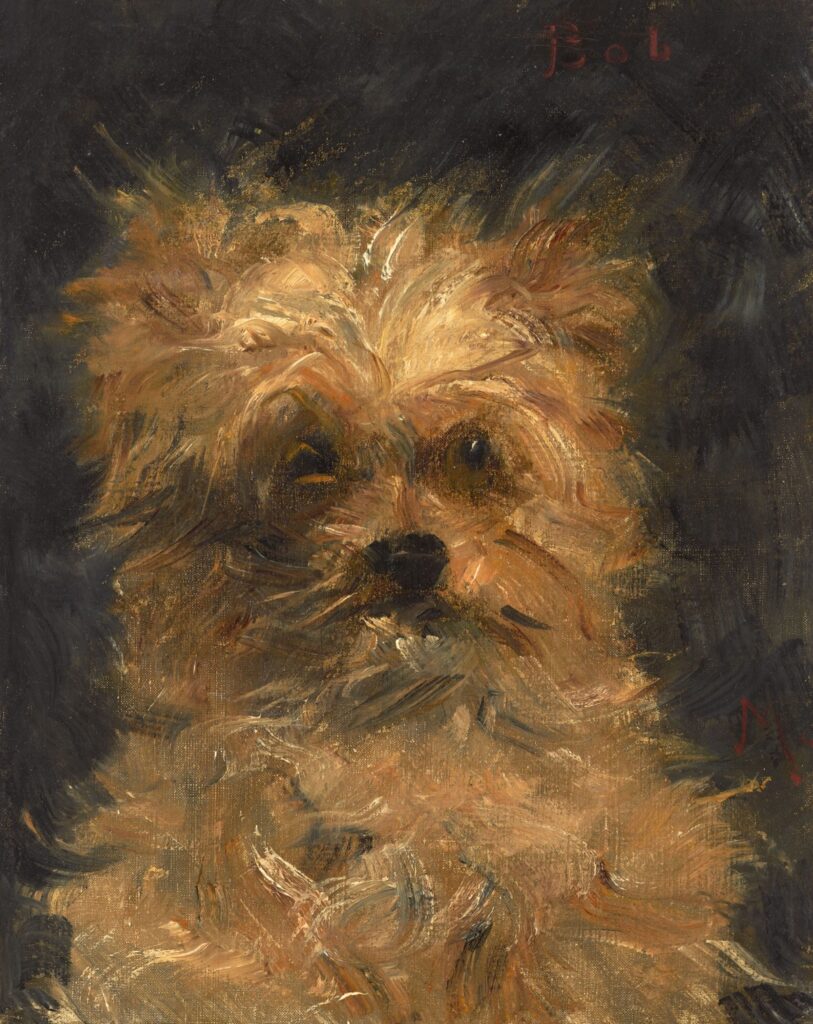
Lot. Number. One.
This is just a placeholder post because I really am deep in something else at the moment, but Tête du chien “Bob”, one of Manet’s awesomest dog portraits (it really is a small set of a very small list), will be sold next month at Christie’s. For forty years, it belonged to Ann & Gordon Getty, who loaned it just once? Really?? To the Getty. For the 2019 exhibition, Manet and Modern Beauty.
And now it will be sold.
“Bob” will be on view at Christie’s in New York for at most six days, October 15-20, and is the first lot in the first Getty sale the evening of the 20th. The estimate is $400-600,000, so in line with the result for Minnay last year.
There is drama, though it is resolved drama, around the provenance of “Bob”; the Getty Estate has made an agreement with the heirs of an earlier owner, Estella Katzenellenbogen, of Berlin and Santa Monica, who owned the painting at least until 1945, though she made it to the US by 1940. Whether the painting was left behind in Europe and then turned up at Carroll Carstairs Gallery in New York in 1947, or was the subject of some kind of ownership or consignment dispute before passing through Carstairs’ hands is not clear, but either way, the Katzenellenbogens are now cool with it.
Wait, there’s another?? “A second portrait of a dog by Manet, Le chien “Donki,” also owned by Ann and Gordon Getty, is being offered in the Old Masters, 19th and 20th Century Paintings Day Sale on October 21st.”
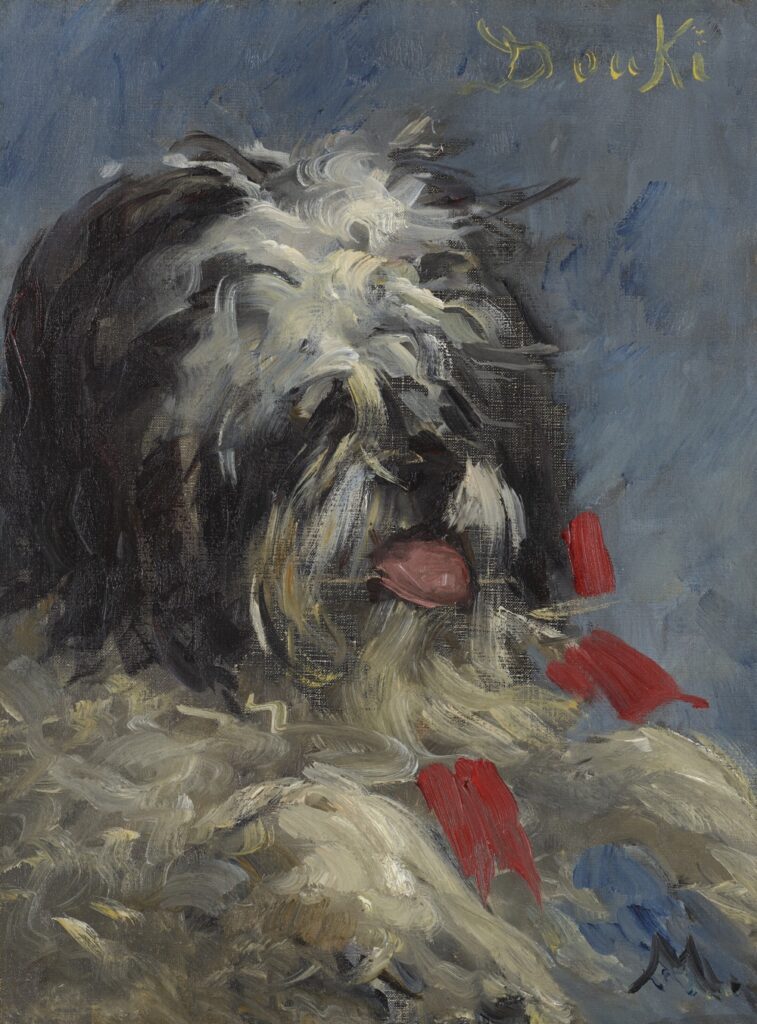
The next day! Le chien “Donki”, along with “Bob” and Minnay, are the three best Manet dogs. Granted, there are only eight, and this is not a hot or studied genre, like his late bouquet paintings, but maybe it should be. “Donki” has not been exhibited in almost 80 years.
[I do still think that says “Souki”, not “Donki,” but I accept that actual French people in the early 20th century read that as a “D”. I will also note that they read that as a “u”, not an “n”, and called him “Douki.” If I buy this painting, I will call it “Souki.”]
Frankly, I’ll be lucky to see them IRL. Preview times are the same, so for up to six days before the sales, both paintings should be on view in New York. It’s also possible they’ll be included on a Getty highlights tour to Shanghai, London, and Los Angeles. In the mean time, here is a pic of what they looked like in situ, from the incredible virtual tour of the Gettys’ maxed out San Francisco house:
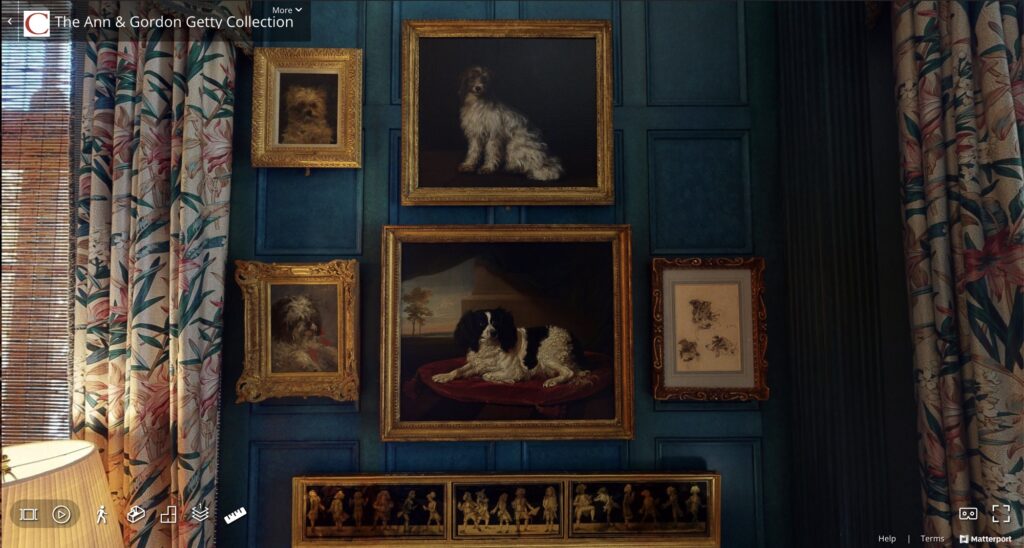
We know that, at less than 13×10 in. for “Donki”, and like 10.75 x 8.25 in. for “Bob”, these are the perfect Manets to flee the Nazis with, should the need ever arise again.
The Ann & Gordon Getty Collection, 10 sales, 1,385 lots [Christies.com]
Previously, very much related: Manet Paints Dog
Édouard Manet Facsimile Object
I am kind of deep in an assignment, and so cannot really give the space right now to process the news of Jean-Luc Godard’s death and the impact of his work.
But as an absolute fan of Agnes Varda who has not seen Faces Places because I detest JR’s work, Manohla Dargis’s interpretation here of Godard’s refusal to even come to the door makes sense to me.
The beautiful, melancholic and now portentous video by Robert Luxemburg of Godard and Anne-Marie Miéville captured on Google Street View in 2013, set to music from Le Mepris, is the kind of cinematic world we all inhabit now. Of course, he is in it forever.
UPDATE: NEVERMIND.
I thought of the Fourth Plinth, empty. And the sixteen artists who’ve made sculptures to fill it, (counting Elmgreen and Dragset and the two who are in the queue).
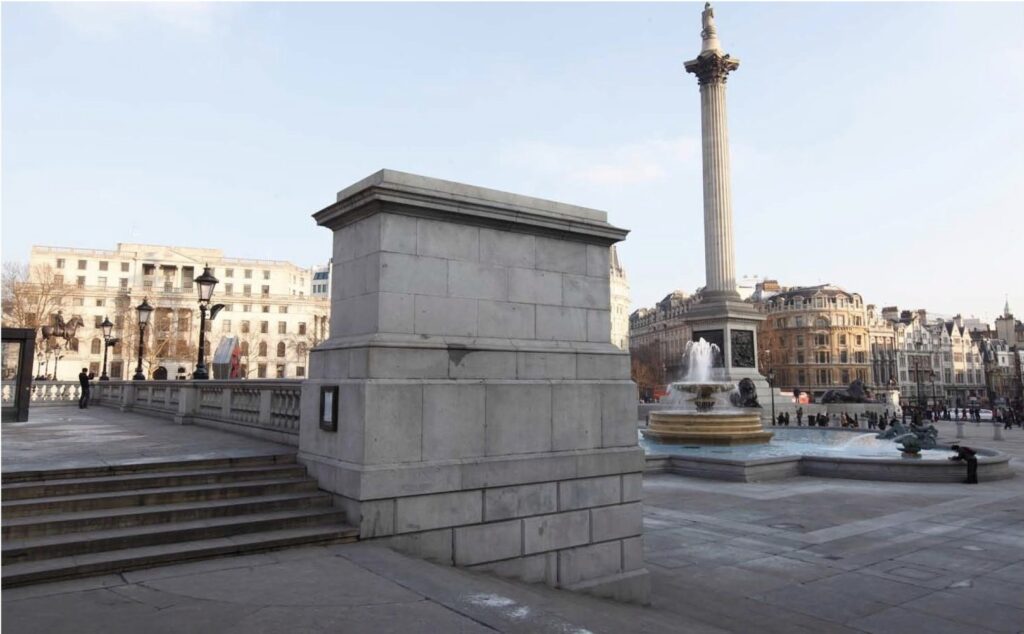
Actually, I thought of the Corgis first. The Queen had had over 30 Corgis, most bred from a dog named Susan, who was given to her on her 18th birthday. Though the royal breeding operation had ceased, in 2022, The Queen still had at least two Corgis and a Dorgi, a dachshund/Corgi mix The Queen and her sister Margaret delighted in since an errant hookup in the 1970s, and which was facilitated, The Queen once actually explained, by the use of “a little brick.”

“The Queen is said to be unwilling to leave young dogs behind when she dies,” the BBC also blithely reported in June, so the thought of some household staff carrying out The Queen’s dying wish to have her dogs killed after her own death–even if it should be a shock–can’t be said to come as a surprise. People should know and remember that decision.
Which is when I thought of the Fourth Plinth. A dog killed and buried with its royal owner. A dog on a plinth. I thought of the Anubis Shrine unearthed in the tomb of Tutankhamun.

The Anubis statue was wrapped in a linen shirt which was from the seventh regnal year of the Pharaoh Akhenaten, according to an ink inscription on it. Underneath was a very fine linen gauze tied at the front of the neck. Over this were two thin floral collars of blue lotus and cornflowers, tied at the back of the neck.[4] Between the front legs sat an ivory writing palette inscribed with the name of Akhenaten’s eldest daughter, Meritaten.
Howard Carter documented in 1927.
No, that’s not the vibe. Anubis led the funeral procession of the pharoah, and, as was evident by the inscription on a “magic brick” of unfired clay found in front of the statue on its palanquin, was positioned to guard the Necropolis:
It is I who hinder the sand from choking the secret chamber, and who repel that one who would repel him with the desert flame. I have set aflame the desert (?), I have caused the path to be mistaken. I am for the protection of the deceased.
Plus, Anubis is too big. Corgis are small. Like canopic jar small.
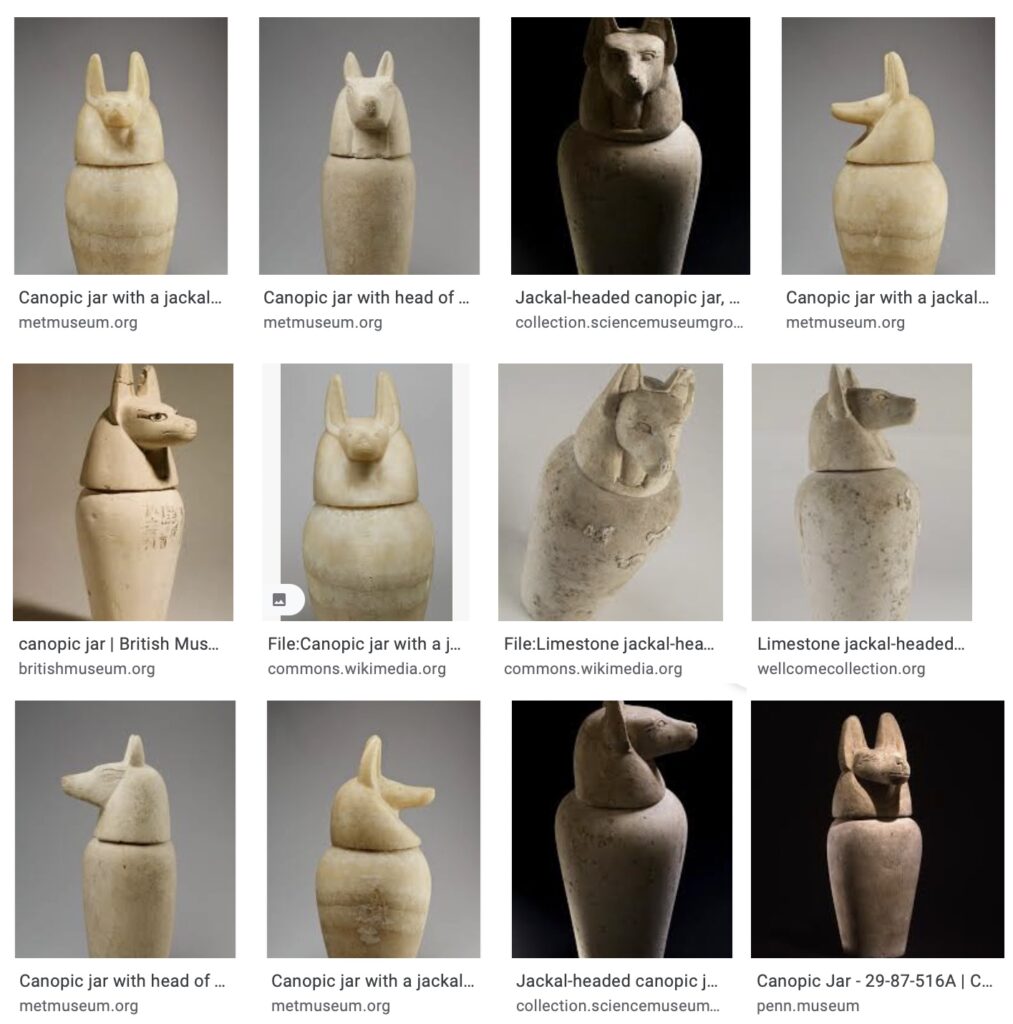
And that is it. So when I looked for an image of the empty Fourth Plinth, I was also surprised to learn that “The Fourth Plinth is Reserved for The Queen.” Even in the mid-2000s, the group in charge of what it calls, “the most important public art commission in the world,” and even the Mayor of London himself were unaware of this plan to commission an equestrian statue of The Queen for the Fourth Plinth after her death. “It’s as if Boris was told the nuclear secret,” a source said to the Independent when the royal family’s plan was revealed to the then-mayor in 2008.
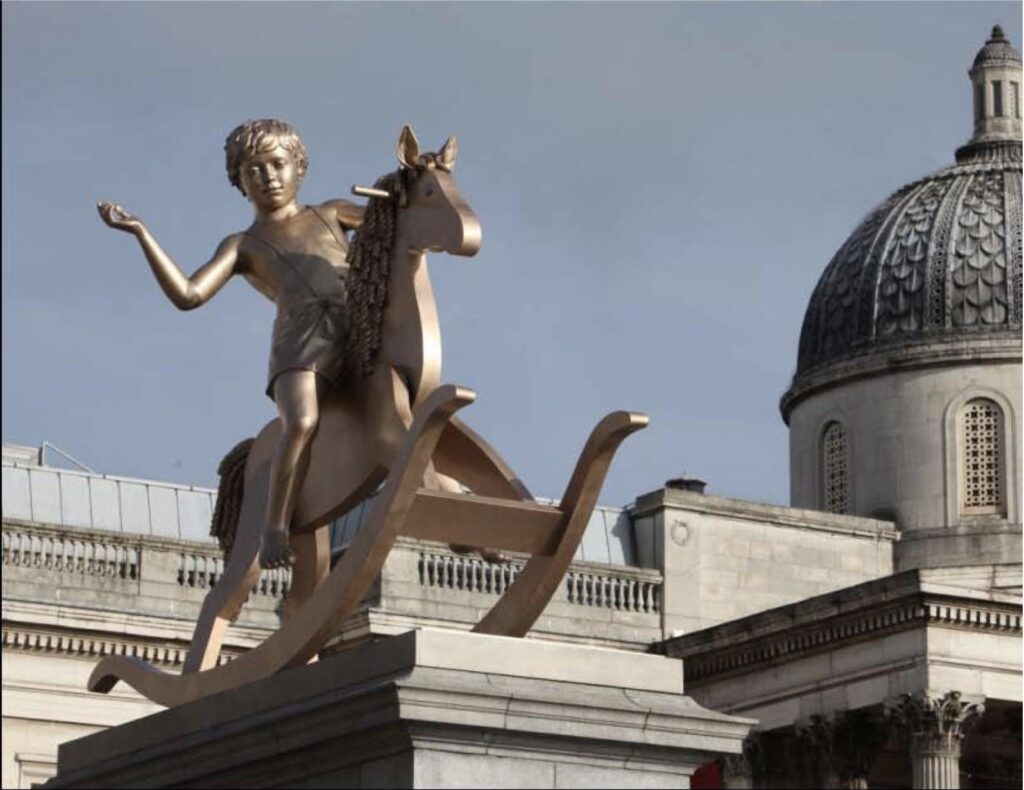
So since 1999 everyone involved in the Fourth Plinth has really just been running interference, keeping the plinth busy–and clear from any competing permanent proposals. Did Elmgreen & Dragset know? Did Hans Haacke?
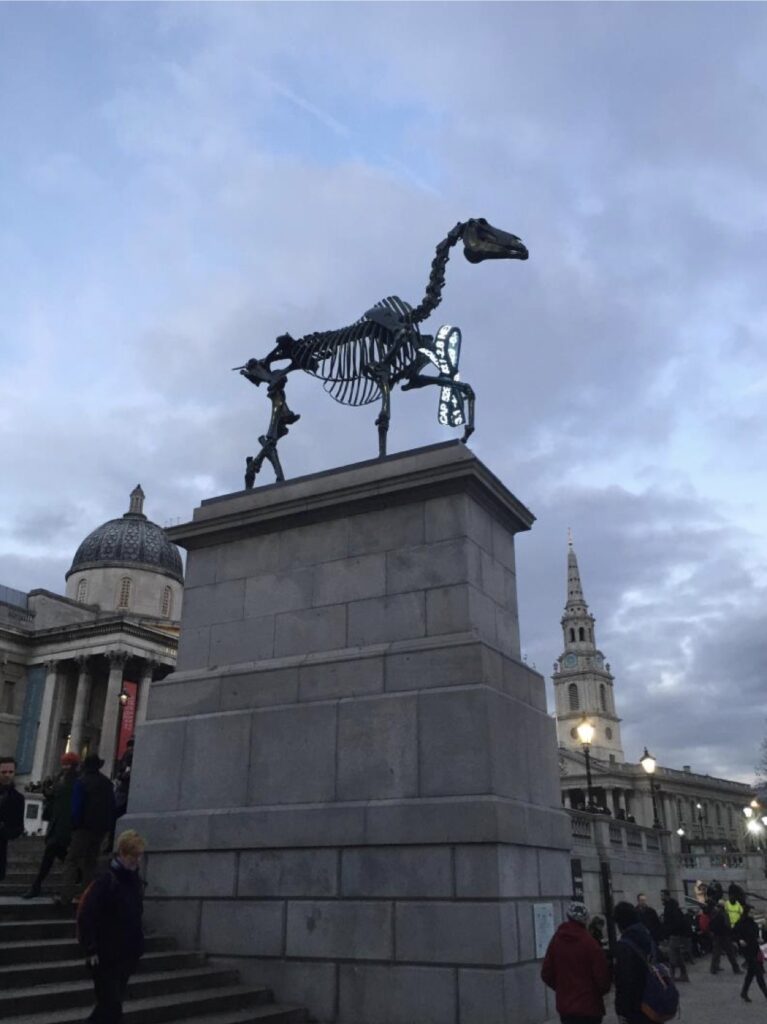
So it’s been a fait all along, just waiting to be accompli. Fine. Just as long as when the statue of The Queen on horseback is finally unveiled, the edge of the Fourth Plinth is lined with canopic jar-sized memorials to the Corgis The Queen had killed at her death.
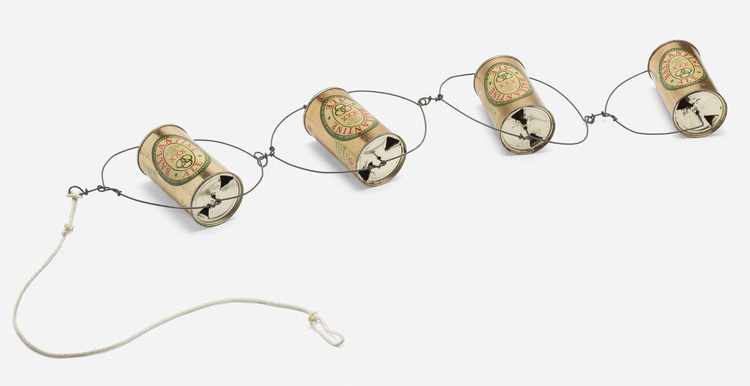
“Calder, you could give that son of a bitch four beer cans and he’d make a toy out of them and give them to the toddler son of the next door neighbor in Roxbury who helped build his studio and became a lifelong friend, and then eventually he’d sell ’em,” deKooning probably did not say, but yet, here we are.
14 Sept. 2022, Lot 122: Alexander Calder, Untitled (Pull Toy), 1955, est. $50-75,000 [ragoarts.com]
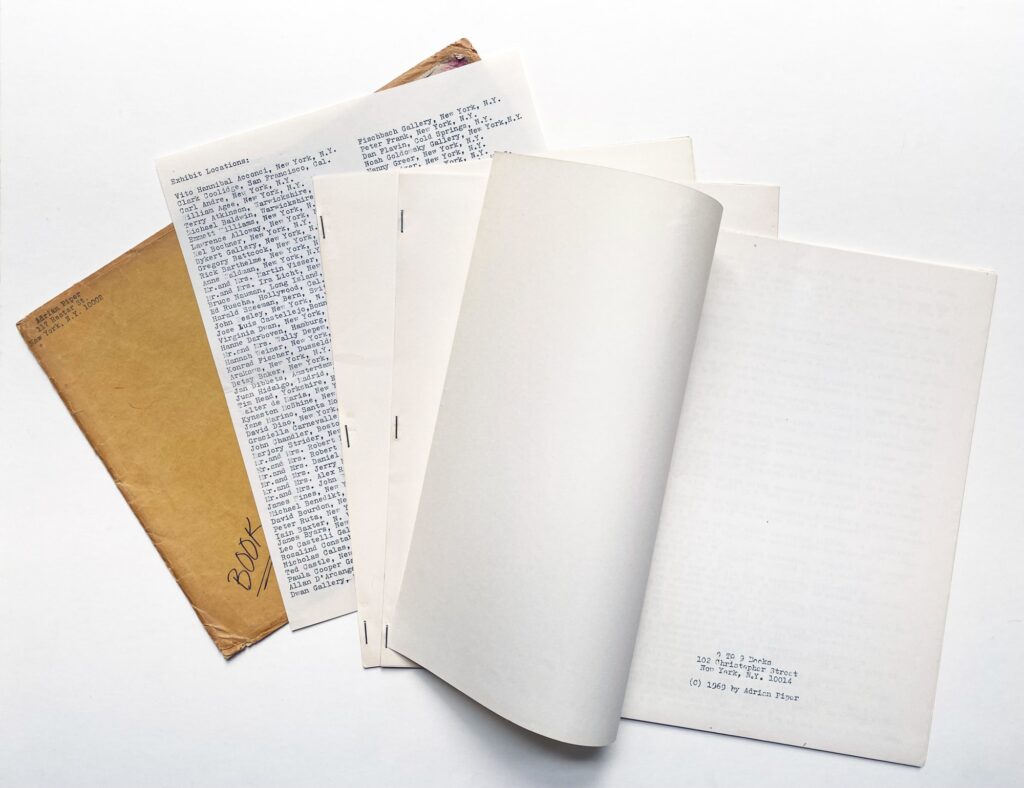
Three Untitled Projects, also known as Three Untitled Booklets, is considered Adrian Piper’s first exhibition. It was a site-specific exploration of identifying place, and it took the form of three mimeographed books, which she mailed to artists, curators, critics, and collectors in the Spring of 1969. In addition to the books, each recipient of the show got a list of all 162 locations for the show–the list of all the mailing’s recipients–with their name and location highlighted.
As David Platzker of Specific Objects wrote in the catalogue of the artist’s 2018 MoMA retrospective, Piper, a student at SVA, was hired as a secretary by Seth Siegelaub during his last gallery exhibition, in January 1969:
Piper, between her gallery responsibilities, clandestinely copied Siegelaub’s Rolodex, utilizing the dealer’s mailing list to distribute copies of her artist’s project, a set of three untitled books she intended as independent works titled Three Untitled Projects [for 0 to 9]: Some Areas in the New York Area (1969).
…
The triptych publication, in concert with its means of distribution, expanded on Adrian Piper’s inquiry into spatial relationships as fixed constructions defined by the limits of the human mind. By putting the project directly in the hands of her influential intended recipients, Piper utilized one of the significant strengths of artists’ books, which is to extend works of art to individuals—domestically and internationally—who might not otherwise see the work in a gallery setting. Piper’s project became a primary example of how publications traverse not just fixed locations, but the durational nature of presenting art in fixed locations.
I love that so much.
Piper was associated with 0 to 9, the art journal and artist publishing project of Vito Acconci and Bernadette Mayer, which ran for six issues and a supplement beginning in 1967 and ending in 1969. Which is wild; you’d think scoring Seth Siegelaub’s mailing list would set a mimeographed mail art operation up for life.
An edition of Three Untitled Projects will be included in an exhibition, whose title–I think it’s the title?–is a Judd quote: “I Can’t See How I Can Be Outside of the Society–So I Am Within It,” Specific Object at Susan Inglett Gallery, at the Independent 20th Century Fair in New York, 8-11 September, 2022.
I CAN’T SEE HOW I CAN BE OUTSIDE OF THE SOCIETY— SO I’M WITHIN IT. [specificobject]
Ugly Duckling Presse reissued 0 to 9 a few years ago as a single volume trade edition and in a signed, facsimile special edition. It does not include Three Untitled Projects. [uglyducklingpresse.org]
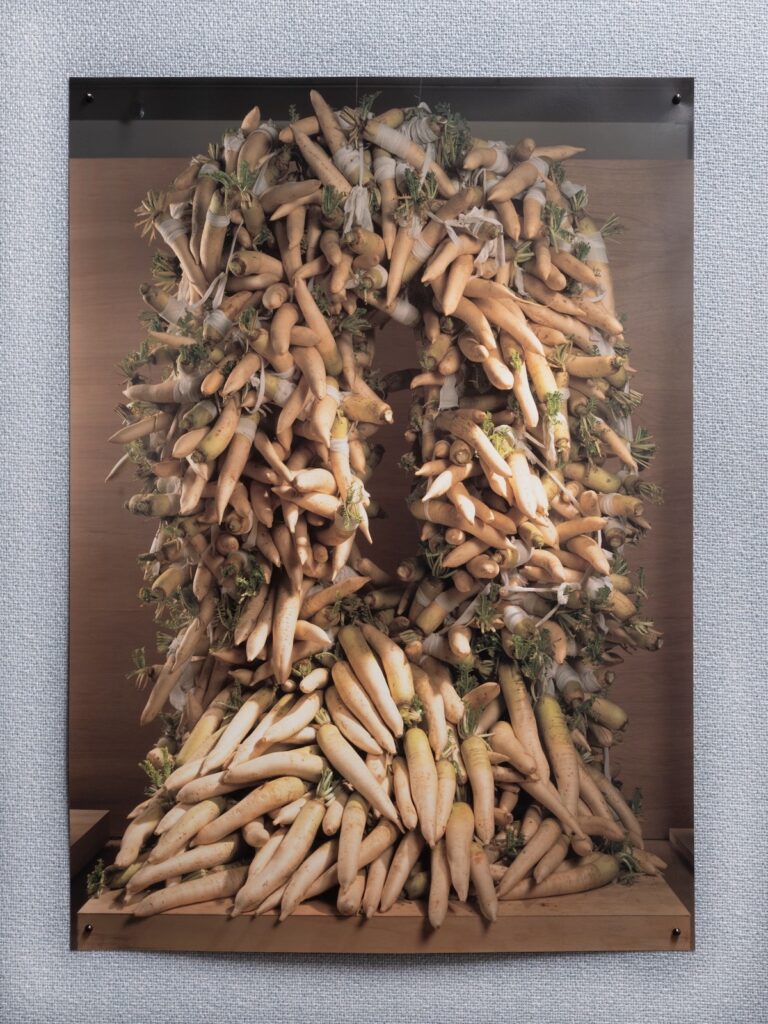
Friend and hero of the blog Christian Alborz Oldham has long been an insightful thinker and practitioner of ikebana and its relationship to contemporary developments in art, both in Japan and beyond. In late July and early August he curated an exhibition of archival photos of one of the masters of contemporary/freestyle ikebana, Kosen Ohtsubo, at Paid in Seattle. It was arranged in collaboration with the artist, his school Ryusei-ha, and Empty Gallery of Hong Kong, and is accompanied by an essay by Oldham, and archival writings and reviews of Ohtsubo’s work. The show’s closed now, but installation images are available, and open edition posters of a selection of the images are available via Device for US shipping.
Without getting too this-looks-like-that about it, the work above, Rock & Roll Radish Tower, suddenly reminded me of Yayoi Kusama’s work, especially the stuffed shadow boxes she made in the ’80s. I mean, the daikon’s phallic symbolism is as much a staple of Japanese culture as the daikon itself. There’s definitely enough to go around.
Christian Kōun Alborz Oldham Selections from the Photographic Archive of Kosen Ohtsubo, Presented by Christian Kōun Alborz Oldham, and in cooperation with Kosen Ohtsubo, Ryusei-ha, and Empty Gallery July 23 – August 6 [paid.exchange, that’s the url, not spon disclosure]
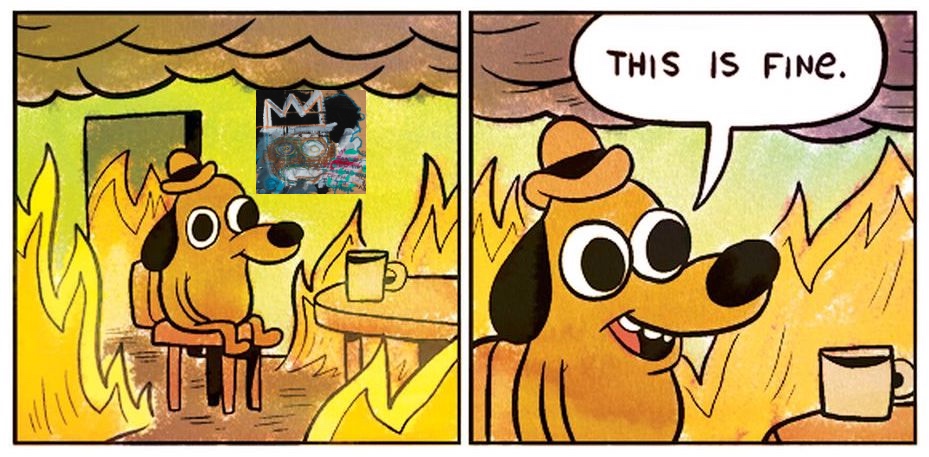
The Florida Man of museum scandals just keeps on going. The NY Times now reports the director of the Orlando Museum of Art and the chair of the board of trustees received a subpoena from the FBI for all communications relating to a group of fake Basquiats in 2021, months *before* the museum opened a show of the works. And instead of canceling the show, they covered up the subpoena, and swore the trustee running the finance committee to secrecy, and threatened any museum employee who talked or raised any objections with instant termination, and threatened *via email* the job of the art professor who objected to finding out her name was being used to authenticate the works she had never seen in person. And that is barely a third of wtf is in the latest article. Why did this backwater museum director ride so hard for these blatantly faked Basquiats in the first place, and why did he and his board chair make things a million times worse for themselves after they knew the jig was up?
An Orlando Museum’s Disputed Basquiats Are Gone. It’s Leadership Is, Too [nyt with the hard underselling headline]
Jacob Kassay, 'BRUSH', 2020 – Interview filmed in March 2022 at Art : Concept, Paris.
In March 2020, as was the custom of the time, Jacob Kassay did an OVR, with a show no one could see at Galerie Art Concept in Paris of 19th century bricks made in Buffalo. That was followed by a bigger show, F’O’O’T’A’G’E’, in the summer. This past March, he talked about them in a brief video, above, which, like the rest of this pandemic, feels like time and space have collapsed.
The project is balanced in the space between these quotes: “I mean, I am relying on the pretension of people knowing about my relationship to painting for these to operate in a certain way.” and “I don’t think I have the ego enough to say like, ‘Oh, this is a readymade.'”
The word “balance” suddenly made me think of another work of saliently stamped bricks, but since it dates from the year after Ana Mendieta’s death, I’m not going to mention it here.

Which has apparently been removed from Google Maps? [h/t @bbhilley]
Previously, related, from 2005 (!): Earth Art via Satellite
cf. Peter Morse’s early roundup of looking for Earth Art via Google Maps [archive.org link]
2002: arguing with the guy who wrote for Artforum about not being able to find the Spiral Jetty [sheesh, I was insufferable, but so was everybody else. 2002 really was another internet country.]
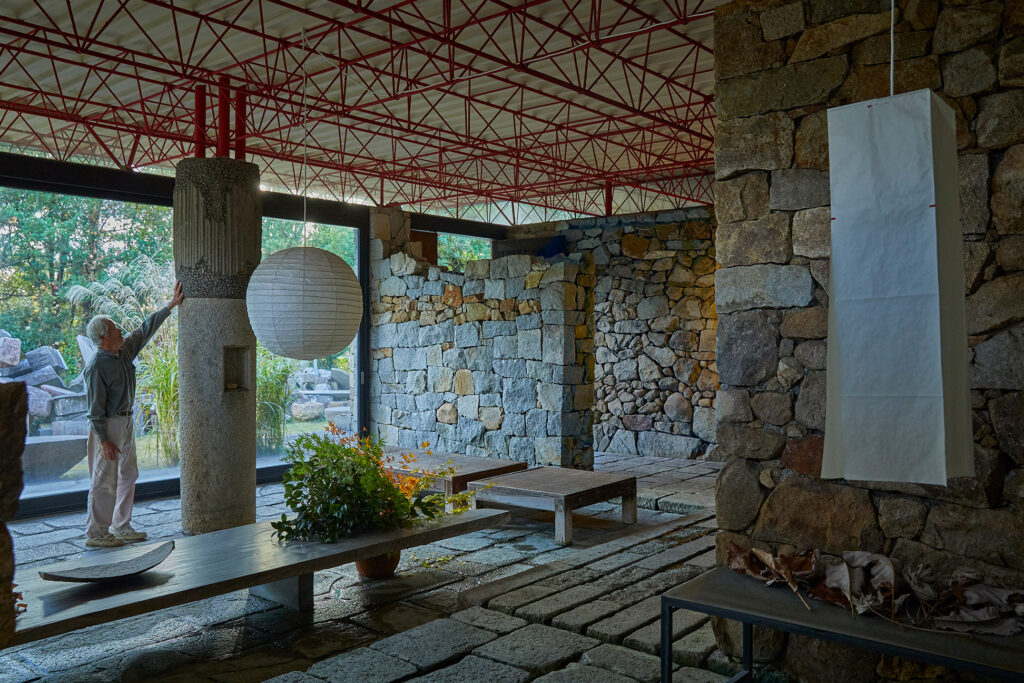
Searching for Isamu Noguchi ceiling is highly recommended.
In 1972, the Noguchi’s longtime collaborator, Masatoshi Izumi, built a house next to the artist’s at their stonecutting yard in Mure, Japan. Izumi, who descends from a long line of stonecutters, worked with a plan by architect Tadashi Yamamoto to realize Stone House. Jared Frank wrote about it for Cereal Magazine:
This salvaged cylinder [made from local aji stone, and the basalt core of the first sculpture Izumi and Noguchi created together] still bears the scars of its violent removal, and is the physical and spiritual core of Stone House. It supports a slender truss system that floats over the walls. Painted red at Noguchi’s urging, the grid is flagrantly hi-tech in contrast with the low-tech stonework. Equal parts Superstudio, Cedric Price, and Bernard Rudofsky’s Architecture Without Architects (1964), Stone House is a compelling, one-of-a-kind synthesis of competing trends in late modernist thought and design. To this day it remains both timeless and distinctly 1972. Noguchi appropriately dubbed it a “modern temple.”
Here are more of Yoshihiro Makino’s photos of Stone House. And a 2018 tumblr post with photos from a Japanese magazine feature.
I went to Noguchi’s Museum and house in Mure when we went to Naoshima in 2006, but I did not know to put Stone House on the itinerary. [1 hour of google map searching later update: it is not next to Isamu-ya, Noguchi’s reconstructed Ed0-era house. I feel better about missing it.] [and one minute of googling a year later update: Izumi passed away in 2021.]